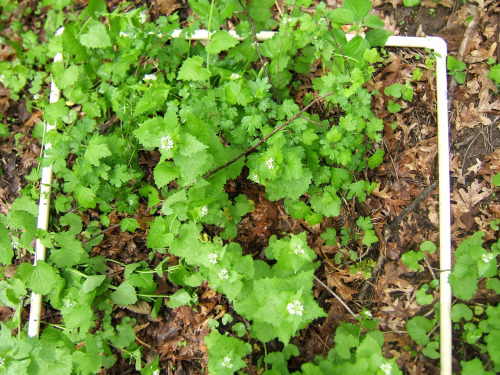Garlic mustard in New York
Garlic mustard is characterized primarily by its hardiness-it is capable of reestablishing itself within a year of being physically removed from a location-as well as its toxic attacks on its competitors. The sinigrin compound produced by these plants is used to kill the fungal symbionts that allow native plants to extract and utilize nutrients from the soil, effectively starving them to death and allowing invasive growth to occur relatively uninhibited.
It has long been thought that native plants would never be able to reclaim the competitive advantage in the face of the garlic mustard onslaught, but a recent study published in PNAS (Lankau, 2012) by a team of scientists from the University of Georgia suggests that this might not be true after all.
Instead, they discovered that native clearweed plants (Pilea pumila) located in areas that have been exposed to garlic mustard for extended periods of time have gradually evolved an increased resistance to sinigrin in order to enhance their survival. In response to this challenge of their regional dominance, garlic mustard plants in these areas are attempting to overwhelm clearweed resistance mechanisms by increasing the volume of sinigrin they produce. These findings are significant because they represent the first evidence of coevolution-change in one object triggered by change in another- between native and invasive plant species.
Clearweed and garlic mustard existing side-by-side
The process of evolution comes with a cost, however. The researchers also determined that sinigrin-resistant clearweed was largely incapable of surviving in areas possessing little to no garlic mustard. In fortifying their defenses, the modified plants appear to have sacrificed some of their fitness relative to their less-resistant brethren.
Despite their narrowed habitat niche, the evolution of sinigrin-resistant clearweed provides hope for the long-term state of ecosystems affected by invasive species. If it is indeed possible for native plants to effectively fight species such as garlic mustard to a relative draw, then it is logical to assume that they will achieve some sort of equilibrium in the future. Whether this means the two species will simply coexist or eventually coevolve new relationships that cause them to integrate remains to be seen, but the long-term outlook for ecosystem health certainly looks much brighter than before. Invasive species will never be completely eradicated from our forests, but thanks to the power of evolution, they can at least be tamed.
Word Count: 445
Source cited: Lankau RA. Coevolution between invasiveand native plants driven by chemical competition and soil biota. PNAS. 2012 Jul10;109(28):11240–5.
Photo credits: Garlic mustard-http://newyorkinvasivespecies.info/plants/GarlicMustard.aspx
Clearweed and garlic mustard-http://laboratoryequipment.tumblr.com/post/26213793859/invasive-species-such-as-kudzu-privet-and-garlic


This is very interesting because while the native species evolved to fight against the invasive species it is now dependent on it as well. I've heard that sometimes to fight against invasive species scientists introduce another species (a different plant or an insect) into the environment that would hopefully target the invasive species and kill it off. However, there have been multiple instances that while the new species kills the invasive species it also attacks all remaining native species as well. It is extremely hard to control how a species will actually act in a certain environment. That is why I think it is great that native species are evolving to re-establish themselves in the environment.
ReplyDeleteIt is interesting that this native species was able to develop some resistance to an invasive, especially because the invasive seems so competitive. One would think that the native species would have not chance to evolve because its population (and thus the genetic variation)would be limited by the the rapid takeover of the garlic mustard plant. I think this is a good example of how quickly evolution can occur when there is a strong selective pressure.
ReplyDeleteIt is possible that a new species could evolve from clearweed in this situation (divergent evolution). The original clearweed that was driven to very low numbers could potentially move to a different physical location, develop a new niche, or remain as it is while the new sinigrin-resistant clearweed continues to evolve into a new species with different adaptations and a new niche.
ReplyDeleteConsidering the catastrophic way that invasive species are often portrayed by the media, it is nice to hear that native species have some hope of surviving an invasion. Is it known what unique characteristics of the clearweed (e.g. short generation times) allowed it to adapt to the presence of garlic mustard, rather than succumbing to it? Also, do you think if more native/invasive species co-evolution occurs, there will be less of an effort put forth to remove invasive species (because doing so will negatively impact native species)?
ReplyDeleteThe conclusion you draw about the eventual relationship between garlic mustard and clearweed is very interesting. If these two species have evolved in such a way that sinigrin-resistant clearweed cannot survive without the invasive species, I wonder what other examples of this phenomenon must exist. If native plants are diversifying as a result of invasive species, I imagine that the entire ecosystem could look very different given enough time.
ReplyDelete